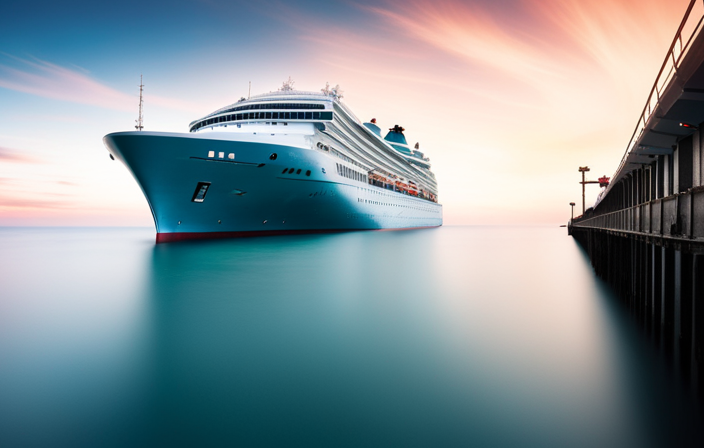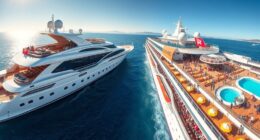Ever wondered where cruise control came from? Let me take you on a journey through the fascinating history of this revolutionary automotive technology.
Imagine yourself driving along a long stretch of road, your hands lightly gripping the steering wheel, and your foot resting comfortably on the gas pedal. Suddenly, a thought crosses your mind – wouldn’t it be nice if you could maintain a constant speed without constantly adjusting the throttle? That’s where cruise control comes in. It revolutionized the way we drive, providing convenience and comfort on those long road trips.
But who was the brilliant mind behind this invention? Join me as we explore the early attempts at speed control in automobiles, the first innovators, and the birth of modern cruise control. Get ready to delve into the world of automotive history and uncover the origins of this ingenious invention.
Key Takeaways
- Ralph Teetor invented the Speedostat, an early form of cruise control.
- Cruise control has evolved from mechanical speed regulators to electronic systems.
- Advanced driver assistance systems, including adaptive cruise control, have enhanced driver safety and comfort.
- The future of cruise control holds endless possibilities for improvement, including integration with self-driving cars and advancements in sensor technology.
Early Attempts at Speed Control in Automobiles
Before cruise control became a staple in modern automobiles, early attempts at speed control in cars were far from the seamless experience we know today. In the early days of automobiles, mechanical speed control was the primary method used to regulate vehicle speed. These early speed control devices were simple and rudimentary, often consisting of levers and rods that manually adjusted the throttle or ignition timing. However, these mechanical systems were far from accurate or reliable, often resulting in jerky acceleration or deceleration.
It wasn’t until the 1940s that the first innovators began to develop electronic speed control systems, laying the groundwork for modern cruise control. These early pioneers paved the way for the sophisticated cruise control systems we have today, providing drivers with a more comfortable and convenient driving experience.
The First Innovators
Ralph Teetor, an American engineer, is credited with inventing the Speedostat, an early form of cruise control, in the 1940s. The Speedostat used a mechanical linkage to maintain a constant speed while driving, allowing the driver to relax their foot on the accelerator.
In the early 20th century, mechanical speed regulators were also developed, providing drivers with a way to set and maintain a desired speed without constant manual adjustment.
Ralph Teetor and the Speedostat
Imagine driving down a long stretch of highway, effortlessly maintaining a steady speed without ever having to touch the gas pedal – all thanks to the genius of Ralph Teetor and his groundbreaking invention, the Speedostat. This innovative device, invented in the early 1950s, revolutionized the way we drive by automatically controlling the speed of the vehicle. Teetor, who was blind, came up with the idea after enduring uncomfortable rides due to his chauffeur’s inconsistent driving. Determined to find a solution, he developed the Speedostat, which used a combination of mechanical and electrical components to regulate the speed of the car. The Speedostat worked by maintaining a constant tension on the accelerator pedal, allowing drivers to set their desired speed and then relax while the device maintained it. This invention marked a significant milestone in automotive technology and laid the foundation for future advancements in cruise control. Transitioning to the subsequent section about mechanical speed regulators in the early 20th century, we can see how the Speedostat set the stage for further innovations in the field.
Mechanical speed regulators in the early 20th century
Get ready to travel back in time and discover how mechanical speed regulators in the early 20th century shaped the way drivers maintained a steady pace on the road.
-
Simplicity: Early mechanical speed regulators were designed to be simple and easy to use. They consisted of a lever or pedal that could be adjusted to set the desired speed.
-
Limited functionality: These early speed regulators were not as advanced as modern cruise control systems. They could only maintain a constant speed and did not have features like automatic braking or adaptive cruise control.
-
Advancements in technology: Over time, advancements in speed control technology led to the development of more sophisticated mechanical speed regulators. These included devices that used a centrifugal governor to maintain a constant speed and systems that could be activated by pressing a button.
As technology continued to evolve, the patent wars erupted, with inventors vying for control over the rapidly expanding field of automotive technology.
The Patent Wars
The Patent Wars were a heated battle over the rights to various inventions, including cruise control. In the early 20th century, as mechanical speed regulators started to gain popularity, patent disputes and legal battles erupted between inventors who claimed to have the original idea.
One of the key figures in these conflicts was Ralph Teetor, an engineer who invented an early form of cruise control in the 1940s. However, it wasn’t until the 1950s that his invention was recognized and patented. This marked the birth of modern cruise control as we know it today.
Teetor’s invention paved the way for further advancements in automotive technology, making driving more comfortable and convenient. With the patent battles settled, the stage was set for the subsequent section about the birth of modern cruise control.
The Birth of Modern Cruise Control
When it comes to the birth of modern cruise control, Chrysler is often credited with its introduction. In the 1950s, Chrysler developed a system called ‘Auto-Pilot’ that allowed drivers to set a desired speed and let the car maintain it.
This innovative feature quickly gained popularity and paved the way for the development of electronic cruise control systems, which became more advanced and widely adopted in the following decades.
Today, cruise control is a standard feature in most vehicles, providing convenience and improved safety on long drives.
The introduction of "Cruise Control" by Chrysler
In a stroke of automotive genius, Chrysler introduced the game-changing concept of ‘Cruise Control’, revolutionizing the way we drive. This early implementation of the technology allowed drivers to set and maintain a desired speed without constantly adjusting the throttle.
It was a major step forward in terms of convenience and safety on the road. The introduction of ‘Cruise Control’ by Chrysler was a result of technological advancements in the automotive industry, particularly in the area of mechanical engineering. The system worked by using a vacuum servo to control the throttle, ensuring a steady speed.
This innovation paved the way for the development of electronic cruise control systems, which would later become standard in most modern vehicles. With the introduction of ‘Cruise Control’, driving became a more relaxed and enjoyable experience, allowing drivers to focus on the road ahead.
The development of electronic cruise control systems
After the introduction of Cruise Control by Chrysler in the 1950s, the development of electronic cruise control systems began to take shape. This marked a shift from the earlier mechanical cruise control systems, which relied on purely mechanical components.
The transition to electronic systems brought about numerous advantages, including greater precision and reliability. However, it also presented its own set of challenges. Implementing electronic cruise control required the integration of electronic sensors and control modules into the vehicle’s existing systems, which required significant research and development.
Additionally, the development of electronic cruise control systems necessitated the overcoming of technical hurdles, such as ensuring accurate speed measurement and maintaining consistent control. Despite these challenges, engineers persisted and successfully developed electronic cruise control systems that paved the way for further innovations and improvements in the years to come.
Further Innovations and Improvements
Adaptive cruise control and advanced driver assistance systems are two significant innovations that have further improved the functionality and safety of cruise control.
Adaptive cruise control utilizes sensors and radar technology to automatically adjust the vehicle’s speed based on the distance and speed of the vehicle ahead, providing a more seamless driving experience.
Advanced driver assistance systems go beyond cruise control, incorporating features like lane keeping assist, automatic emergency braking, and blind spot detection. These features enhance overall driver safety and reduce the risk of accidents.
These advancements have made driving more comfortable and secure, allowing drivers to rely on technology to assist with various aspects of their journey.
Adaptive cruise control
Although it may seem futuristic, cruise control has revolutionized the way we drive. One of the latest advancements in cruise control technology is adaptive cruise control (ACC). ACC uses sensors to monitor the distance between your car and the vehicle ahead, automatically adjusting your speed to maintain a safe following distance.
The benefits of ACC are numerous. It can help reduce driver fatigue by taking over the task of constantly adjusting speed. Additionally, it can improve fuel efficiency by maintaining a consistent speed and avoid unnecessary braking. However, there are also some drawbacks to consider. ACC may not work well in heavy traffic or on winding roads, and it can be expensive to repair or replace if it malfunctions.
Transitioning into the subsequent section about advanced driver assistance systems, these technologies are constantly evolving to make driving safer and more efficient without requiring constant input from the driver.
Advanced driver assistance systems
The road becomes a symphony of safety with the harmonious integration of advanced driver assistance systems. These systems have revolutionized the way we drive by incorporating cutting-edge technology that enhances both safety and convenience.
One major advantage of advanced driver assistance systems is increased fuel efficiency. By optimizing speed and acceleration, these systems can help reduce fuel consumption, saving drivers money and benefiting the environment.
Additionally, these systems are designed to assist the driver, resulting in a reduction in driver fatigue. Features such as lane-keeping assist and automatic emergency braking help to alleviate the strain on the driver, allowing them to stay focused and alert for longer periods of time.
With their ability to enhance safety and improve efficiency, advanced driver assistance systems have truly transformed the driving experience.
Transitioning into the subsequent section about the impact and evolution of cruise control, it is important to recognize the significant role these systems have played in shaping the future of automotive technology.
The Impact and Evolution of Cruise Control
Cruise control has had a significant impact on driving, providing increased safety and comfort on long drives. By allowing drivers to maintain a consistent speed, it helps prevent fatigue and reduces the risk of accidents caused by speeding.
In addition, cruise control has evolved to integrate with other automotive technologies, such as adaptive cruise control. This technology automatically adjusts the speed to maintain a safe distance from the vehicle ahead.
Increased safety and comfort on long drives
Driving on long trips can be made more enjoyable and secure with the use of cruise control. Here are four reasons why cruise control enhances safety and comfort on extended drives:
-
Increased Fuel Efficiency: Cruise control helps optimize fuel consumption by maintaining a consistent speed, reducing unnecessary acceleration and deceleration.
-
Driver Distraction Reduction: By taking over the task of maintaining a steady speed, cruise control allows drivers to focus more on the road ahead, reducing the risk of distractions.
-
Reduced Fatigue: Maintaining a constant speed with cruise control reduces the physical and mental strain on drivers, preventing fatigue and improving overall comfort.
-
Smoother Driving Experience: Cruise control ensures a more stable and consistent driving experience, minimizing jerky movements and providing a smoother ride.
With these benefits in mind, let’s explore how cruise control integrates with other automotive technologies to further enhance the driving experience.
Integration with other automotive technologies
To fully appreciate the seamless integration of cruise control with other automotive technologies, envision yourself effortlessly navigating the open road while various features work harmoniously to enhance your driving experience.
Cruise control is now being integrated with autonomous vehicles, allowing for even greater convenience and safety. With this integration, cruise control can communicate with the vehicle’s sensors and AI systems, adapting to traffic conditions in real time.
However, there are potential challenges and limitations that need to be addressed. One challenge is ensuring that the autonomous systems and cruise control work together seamlessly, without any conflicts or errors. Another limitation is the reliance on accurate sensor data, as any inaccuracies can affect the performance of both the autonomous systems and cruise control.
Despite these challenges, the integration of cruise control with autonomous vehicles holds great promise for the future of driving.
Transitioning into the subsequent section, let’s now explore the role of automation and artificial intelligence in revolutionizing the automotive industry.
The Role of Automation and Artificial Intelligence
In discussing the role of automation and artificial intelligence in relation to cruise control, it’s important to consider the impact of self-driving cars.
Self-driving cars are a prime example of how automation and artificial intelligence are transforming the automotive industry. These vehicles have the potential to revolutionize transportation by offering increased safety, efficiency, and convenience.
Looking ahead, future developments and possibilities include advancements in autonomous technology, such as the integration of machine learning algorithms. This could further enhance the capabilities of cruise control systems.
Self-driving cars and cruise control
Imagine cruising down the highway in a self-driving car, effortlessly maintaining a safe and steady speed with the help of cruise control, a technology invented by a mechanical engineer named Ralph Teetor in the 1940s.
Self-driving technology has revolutionized the automotive industry, allowing for the development of autonomous vehicles that can navigate and operate without human intervention. Cruise control plays a crucial role in these vehicles by enabling them to maintain a consistent speed, which enhances safety and efficiency on the road.
With the advancements in artificial intelligence and automation, self-driving cars are becoming increasingly sophisticated, capable of handling complex driving scenarios and adapting to changing road conditions.
As we look to the future, there are exciting possibilities for further developments in self-driving technology, such as improved sensor systems and enhanced communication between vehicles. These advancements will continue to shape the way we travel and pave the way for a more connected and autonomous transportation system.
Future developments and possibilities
As we continue to explore the fascinating world of self-driving cars and cruise control, it’s impossible not to be excited about the future advancements and emerging technologies in this field. With the rapid pace of innovation, we can expect to see significant improvements in cruise control systems.
One of the most promising areas of development is the integration of artificial intelligence, allowing the cruise control to adapt and learn from real-time data, making it even more efficient and reliable. Additionally, advancements in sensor technology and connectivity will enable cruise control systems to communicate with other vehicles and infrastructure, leading to enhanced safety and traffic management.
The future of cruise control holds endless possibilities, and it’s thrilling to imagine how these advancements will shape our driving experience.
But now, let’s delve into the next section and explore the global adoption of cruise control.
The Global Adoption of Cruise Control
When it comes to the global adoption of cruise control, there are several key points to consider.
Firstly, the popularization of cruise control varies across different regions, with some countries embracing it more than others.
Secondly, cultural and regulatory differences play a significant role in the acceptance and use of this technology.
Lastly, understanding these differences is crucial in order to effectively implement and promote cruise control systems worldwide.
Popularization of cruise control in different regions
Explore how cruise control became popular in various regions and discover how it revolutionized driving for you and countless others.
-
In the United States, regional preferences played a significant role in the popularization of cruise control. American drivers, with their love for long road trips, embraced the convenience it offered.
-
In Europe, where winding roads and dense traffic are more common, cruise control took longer to gain popularity. However, with advancements in technology that allowed for adaptive cruise control, European drivers started appreciating its benefits.
-
In Asia, where traffic congestion is a major issue, cruise control initially faced resistance. But as technological advancements improved its adaptability to different driving conditions, it became more widely accepted.
-
Australia, with its vast open roads, quickly embraced cruise control as it allowed for a more relaxed driving experience on long stretches.
These regional preferences and technological advancements paved the way for cruise control to become a global phenomenon, forever changing the way we drive.
Moving forward, let’s delve into the cultural and regulatory differences that influenced its adoption.
Cultural and regulatory differences
Discover how cultural norms and government regulations shaped the widespread adoption of this groundbreaking driving technology, forever altering the way you navigate the open road. Cultural adaptation played a significant role in the popularization of cruise control across different regions. In some countries, such as the United States, where long-distance road trips are common, cruise control quickly became a standard feature in automobiles. However, in countries with strong cultural preferences for manual driving, like Germany, it took longer for cruise control to gain acceptance. Regulatory challenges also influenced the adoption of cruise control. Different countries have varying speed limits and road safety regulations, which affected the development and implementation of cruise control systems. Despite these challenges, the convenience and safety benefits of cruise control ultimately prevailed, leading to its widespread use in modern vehicles. Transitioning into the subsequent section, the legacy of cruise control goes beyond its initial creation and adoption.
The Legacy of Cruise Control
Imagine the convenience and freedom you would feel with the legacy of cruise control, a technological innovation that forever changed the way we drive.
Cruise control offers numerous benefits, making long drives more comfortable and reducing driver fatigue. By maintaining a consistent speed, it allows drivers to relax and enjoy the journey without constantly monitoring the accelerator pedal.
Additionally, cruise control has a positive impact on fuel efficiency. It helps optimize fuel consumption by keeping a steady speed, minimizing unnecessary acceleration and deceleration. This not only saves money on fuel costs but also reduces the environmental impact of driving.
As we explore the conclusion and reflections of cruise control’s invention, it is important to acknowledge its lasting impact on the automotive industry.
Conclusion and Reflections
As you reflect on the impact of this groundbreaking technology, you can’t help but marvel at how cruise control revolutionized the way we drive, turning long journeys into smooth sailing on the open road. This innovative invention not only increased efficiency but also greatly improved the user experience. Here are five reasons why cruise control continues to be a game-changer:
-
Convenience: Cruise control allows drivers to maintain a consistent speed without constantly adjusting the throttle, making long drives much more comfortable.
-
Fuel Efficiency: By maintaining a steady speed, cruise control helps optimize fuel consumption, resulting in cost savings and reduced emissions.
-
Reduced Fatigue: With cruise control handling the speed, drivers can focus more on the road ahead, reducing fatigue and enhancing safety.
-
Precise Speed Control: Cruise control ensures a steady speed, preventing unintentional speeding and potential traffic violations.
-
Enhanced Relaxation: The ability to relax and enjoy the drive, knowing that the vehicle is maintaining a constant speed, makes for a more enjoyable journey.
Frequently Asked Questions
How does cruise control work?
Cruise control works by maintaining a set speed without the need for continuous driver input. It utilizes various mechanisms and features, such as sensors, throttle control, and speed regulation, to ensure a smooth and consistent driving experience.
What were some early challenges faced during the development of cruise control?
During the development of cruise control, early prototypes faced challenges such as maintaining a consistent speed and accurately detecting changes in road conditions. Testing methods involved trial and error to fine-tune the system’s performance.
Did cruise control have any impact on road safety?
Cruise control has been effective in reducing driver fatigue by maintaining a constant speed, allowing drivers to relax. Road safety statistics indicate a decrease in accidents after its introduction, making it a valuable safety feature.
Have there been any recent advancements or updates in cruise control technology?
Recent advancements in cruise control technology have paved the way for safer and more efficient driving. With features like adaptive cruise control and lane-keeping assist, future innovations aim to further enhance the driving experience and reduce the risk of accidents on the road.
Are there any potential drawbacks or limitations to using cruise control?
Using cruise control can have potential risks, such as reduced driver attentiveness and delayed reaction times. It’s important to remember that cruise control is a tool to assist, not replace, the driver’s responsibilities.
Did the Invention of Cruise Control Lead to the Development of Smart Cruise Control?
The invention of cruise control paved the way for the development of smart cruise control explained. While traditional cruise control maintains a constant speed set by the driver, smart cruise control uses sensors to adjust speed and maintain a safe distance from other vehicles. This innovation has revolutionized the driving experience.
Conclusion
In conclusion, cruise control has revolutionized the way we drive, like a gentle breeze guiding us along the open road. From its humble beginnings to the advancements of automation and artificial intelligence, cruise control has become a staple feature in cars worldwide.
Its legacy is one of convenience and safety, allowing us to relax and enjoy the journey. As we reflect on its invention and evolution, we can appreciate the ingenuity and determination of those who paved the way for this groundbreaking technology.
Meet Asra, a talented and adventurous writer who infuses her passion for exploration into every word she writes. Asra’s love for storytelling and her insatiable curiosity about the world make her an invaluable asset to the Voyager Info team.
From a young age, Asra was drawn to the power of words and their ability to transport readers to far-off lands and magical realms. Her fascination with travel and cultures from around the globe fueled her desire to become a travel writer, and she set out on a journey to turn her dreams into reality.











